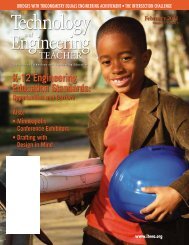Teaching Elements and Principles of Bridge Design - International ...
Teaching Elements and Principles of Bridge Design - International ...
Teaching Elements and Principles of Bridge Design - International ...
Create successful ePaper yourself
Turn your PDF publications into a flip-book with our unique Google optimized e-Paper software.
complex problems in very effective <strong>and</strong> efficient ways that<br />
humans would probably never have thought <strong>of</strong>.<br />
Humans cannot think <strong>of</strong> every possible approach to a<br />
problem. Human invention seems to be limited by what has<br />
been done before <strong>and</strong> by our own brains’ wiring that makes<br />
us want to create things that “look right” <strong>and</strong> fit into some<br />
pigeonhole or category that we already know about. Nature<br />
itself doesn’t have categories <strong>and</strong> fixed notions <strong>of</strong> things.<br />
Nature is limited only by the laws <strong>of</strong> physics. So why can’t<br />
humans use something like those same natural processes<br />
<strong>and</strong> experiments to design new things?<br />
Well, trial <strong>and</strong> error is not really a very efficient way to<br />
design something. It’s much better to use your brain <strong>and</strong><br />
try to figure out what kind <strong>of</strong> design would work best<br />
before you go to all the trouble to build it <strong>and</strong> test it to see<br />
if it would work in the real world.<br />
Evolution in Fast-forward<br />
But what if we could give the “trial <strong>and</strong> error” design job to<br />
a very powerful computer? Suppose we want to design a<br />
new kind <strong>of</strong> mousetrap. We first have to tell the computer<br />
about mice <strong>and</strong> the laws <strong>of</strong> physics, so it will know what is<br />
physically possible out here in the real world (as opposed<br />
to inside the computer). Then we tell the computer what<br />
we want the mousetrap to do. In other words, we think <strong>of</strong><br />
a test the computer can run inside itself: the mousetrap<br />
must attract a mouse, then trap it without the mouse being<br />
able to carry the trap away or escape. Oh, <strong>and</strong> we don’t<br />
want to hurt the mouse—just catch it <strong>and</strong> relocate it from<br />
the city to the country. Then the computer could be<br />
programmed with a list <strong>of</strong> materials or tools (<strong>and</strong> their<br />
characteristics) that the computer could use to create the<br />
mousetrap: plastic, glass, wood, metal, cheese, etc.<br />
To give the computer a bit <strong>of</strong> a head start, we come up<br />
with quite a few designs <strong>of</strong> our own. We feed them (that<br />
is, the exact measurements, materials, <strong>and</strong> other<br />
characteristics) into the computer, <strong>and</strong> let the computer<br />
run its mousetrap testing program on them. The computer<br />
then takes the several designs that did the best, scrambles<br />
up their characteristics a little, then generates a new set <strong>of</strong><br />
designs: Mousetrap Generation<br />
#2. The computer then runs<br />
the same test on this batch <strong>of</strong><br />
designs to see which<br />
mousetraps would do the best<br />
job. It then picks out several <strong>of</strong><br />
the best designs, mixes them<br />
up a little, <strong>and</strong> spits out another<br />
bunch <strong>of</strong> mousetrap designs:<br />
Mousetrap Generation #3. The<br />
computer continues testing,<br />
picking the best performers,<br />
mixing up their traits, <strong>and</strong> creating yet another generation<br />
<strong>of</strong> designs over <strong>and</strong> over <strong>and</strong> over. Eventually, maybe after<br />
a million generations, one mousetrap passes the test<br />
perfectly <strong>and</strong> no further designs can do any better. The<br />
perfect non-destructive mousetrap! The computer prints<br />
out the design specifications, real people build <strong>and</strong> test it in<br />
the real world, <strong>and</strong> it works! But what does it look like? It<br />
just might not look like any mousetrap anyone has ever<br />
imagined before!<br />
An “Out-<strong>of</strong>-the-Box” Antenna <strong>Design</strong><br />
It is as computers have become very fast <strong>and</strong> very<br />
powerful that designing “nature’s way” has become<br />
practical. Engineers at NASA’s Ames Research Center in<br />
Silicon Valley, California, have used the technique <strong>of</strong><br />
evolutionary computation, also called artificial evolution, to<br />
design a tiny communications antenna to be used in the<br />
three small TV-sized satellites <strong>of</strong> the Space Technology 5<br />
(ST5) mission. Many r<strong>and</strong>om designs were tested in a<br />
computer—or, actually 35 computers working together.<br />
The computer judged their performance against certain<br />
goals for the design: efficiency, a narrow or wide broadcast<br />
angle, frequency range, <strong>and</strong> so on.<br />
As in nature, only the best performers were kept, <strong>and</strong> these<br />
served as parents <strong>of</strong> a new generation. To make the new<br />
generation, the traits <strong>of</strong> the best designs were r<strong>and</strong>omly<br />
mixed by the computer to produce fresh, new designs—<br />
just as a father <strong>and</strong> mother’s genes are mixed to make<br />
unique children. This new generation was again tested in<br />
the computer simulation, <strong>and</strong> the best designs became the<br />
parents <strong>of</strong> yet another generation.<br />
This process was repeated millions <strong>of</strong> times, until one best<br />
design emerged that wouldn’t improve any further. With<br />
today’s fast computers, millions <strong>of</strong> generations can be<br />
simulated in only a day or so.<br />
The result: an excellent antenna with an odd shape no<br />
human would, or could, design.<br />
Tiny communications<br />
antenna designed by a<br />
computer using artificial<br />
evolution for Space<br />
Technology 5 spacecraft.
















